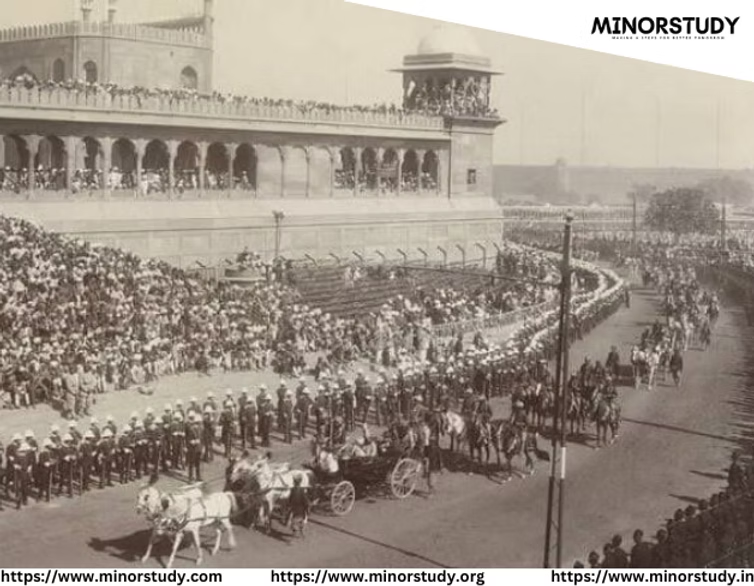The Shift of the Capital of India from Calcutta to Delhi: Overview
Calcutta to Delhi: The capital of India was officially shifted from Calcutta (now Kolkata) to Delhi in 1911, marking a significant event in India’s colonial history. This decision was made by the British during the reign of King George V. The shift was not only a political and administrative move but also had deep symbolic and strategic implications. Below is a comprehensive look at the history, facts, timeline, significance, and more related to this important event.
History Behind the Shift
Before 1911: Calcutta (now Kolkata) served as the capital of British India since 1772. The city’s position along the eastern coast made it a natural hub for trade and governance.
Reasons for the Shift:
Strategic Location: Delhi’s central location was seen as a better position for administration, allowing more effective control over the entire country.
Security Concerns: Calcutta’s coastal position made it vulnerable to attacks and unrest, particularly after the 1857 rebellion.
Symbolic Significance: Delhi had historical importance as the seat of several past empires, especially the Mughal Empire. The British chose it to assert their power and dominance over India.
Logistical Reasons: The British needed a city that could be developed as a modern capital, and Delhi offered ample space for expansion.
Delhi Durbar (1911): The official announcement of the shift took place during the Delhi Durbar held in December 1911, which was a grand ceremony marking King George V and Queen Mary’s visit to India.
Timeline of the Shift
Event | Date |
Capital of British India in Calcutta | 1772 |
Delhi Durbar Announcement | December 1911 |
Construction of New Delhi | Began in 1912 |
Official Move of Capital to Delhi | 1912 |
Completion of New Delhi | 1931 |
Delhi Becomes Capital of Independent India | 15th August 1947 |
Significance and Importance
Symbolic Shift: The move from Calcutta to Delhi symbolized the changing power dynamics between the British Empire and India. It also marked the end of Calcutta’s dominance and the rise of Delhi as the heart of political power in India.
Strategic Importance: Delhi’s location at the center of the country provided better administrative control over both northern and central India, which had become important due to rising nationalistic movements.
Development of New Delhi: The British undertook large-scale urban planning for the development of New Delhi, which was designed by the famous architects Sir Edwin Lutyens and Herbert Baker. New Delhi was envisioned to be a modern city with wide boulevards, grand buildings, and a robust administrative structure.
Important Facts
Calcutta to Delhi: Calcutta served as the capital of India for 139 years before the move to Delhi.
Delhi Durbar: The Delhi Durbar of 1911 was one of the most extravagant events of the British Empire in India, marking the announcement of the capital’s shift.
Architectural Impact: The construction of New Delhi was a monumental project that included the creation of several iconic landmarks such as the India Gate, Rashtrapati Bhavan, and Parliament House.
Centralization of Power: Moving the capital to Delhi helped centralize political and administrative power, giving the British better control over the country during the colonial period.
Significance in Modern India
Political Center: New Delhi is now the capital of independent India, serving as the political and administrative center of the country. It hosts the Parliament, the Presidential Palace (Rashtrapati Bhavan), and other key government offices.
Cultural Symbol: The shift to Delhi marked a significant period in India’s history, blending colonial legacies with India’s rich historical traditions. It is also home to several significant monuments, temples, and historical buildings.
Urban Planning: The development of New Delhi as a planned city laid the foundation for modern urbanization in India.
Frequently Asked Questions (FAQs)
Why was the capital shifted from Calcutta to Delhi?
The capital was moved for strategic, administrative, and symbolic reasons, including Delhi’s central location, its historical significance, and the security concerns of Calcutta.
When was the capital officially moved to Delhi?
The capital was officially shifted to Delhi in 1911, and the construction of New Delhi began shortly afterward.
Who designed the new capital city of New Delhi?
New Delhi was designed by British architects Edwin Lutyens and Herbert Baker.
Why was Calcutta initially chosen as the capital?
Calcutta was chosen because of its prominence as a commercial and cultural hub, as well as its proximity to British trading routes.
What was the Delhi Durbar of 1911?
The Delhi Durbar of 1911 was a grand ceremony held to announce King George V’s decision to shift the capital from Calcutta to Delhi. It was also a display of British power and control in India.
Quotes and Wishing Messages on the Importance of the Capital Shift
On Delhi’s Historical Significance:”Delhi is not just a city; it is the heartbeat of the Indian subcontinent, where history and modernity coexist in harmony.”
On New Beginnings:”The move of the capital to Delhi was more than an administrative decision; it was the beginning of a new chapter in India’s colonial and post-colonial history.”
On National Unity:”Delhi, the city where the past, present, and future of India converge, symbolizes the strength and unity of a nation that continues to grow and evolve.”
On Legacy:”The shift to Delhi brought with it a legacy of resilience and adaptation, showcasing India’s determination to forge its path in the global arena.”
Important Highlights
Delhi Durbar (1911) was the turning point marking the shift of capital.
Edwin Lutyens and Herbert Baker were instrumental in designing New Delhi.
Central Location of Delhi offered logistical advantages.
New Delhi was designed as a modern city with wide streets, colonial architecture, and important government buildings.
Independent India continues to retain Delhi as its capital to this day, making it a symbol of both the colonial past and modern democracy.
Conclusion
The shift of the capital from Calcutta to Delhi in 1911 was not just a geographical change; it was a monumental event that shaped India’s political, administrative, and architectural landscape. This change marked a turning point in the colonial period and laid the groundwork for the city to become the capital of an independent India. Today, New Delhi stands as a symbol of India’s governance, unity, and progress.








